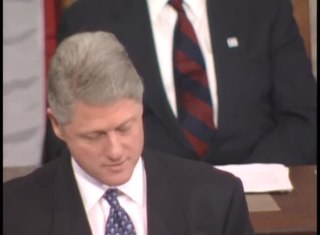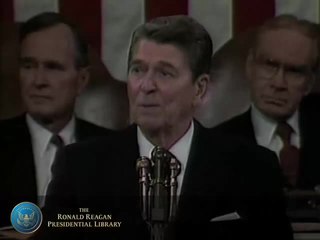Related Research Articles

The State of the Union Address is an annual message delivered by the president of the United States to a joint session of the United States Congress near the beginning of most calendar years on the current condition of the nation. The State of the Union Address generally includes reports on the nation's budget, economy, news, agenda, progress, achievements and the president's priorities and legislative proposals.

Ronald Reagan's tenure as the 40th president of the United States began with his first inauguration on January 20, 1981, and ended on January 20, 1989. Reagan, a Republican from California, took office following his landslide victory over Democrat incumbent president Jimmy Carter and independent congressman John B. Anderson in the 1980 presidential election. Four years later, in the 1984 presidential election, he defeated former Democratic vice president Walter Mondale, to win re-election in a larger landslide. Due to U.S. Constitutional law, Reagan was limited to two terms and was succeeded by his vice president, George H. W. Bush, who won the 1988 presidential election. Reagan's 1980 landslide election resulted from a dramatic conservative shift to the right in American politics, including a loss of confidence in liberal, New Deal, and Great Society programs and priorities that had dominated the national agenda since the 1930s.

The 2000 State of the Union Address was given by the 42nd president of the United States, Bill Clinton, on January 27, 2000, at 9:00 p.m. EST, in the chamber of the United States House of Representatives to the 106th United States Congress. It was Clinton's seventh and final State of the Union Address and his eighth and final speech to a joint session of the United States Congress. Presiding over this joint session was the House speaker, Dennis Hastert, accompanied by Al Gore, the vice president, in his capacity as the president of the Senate.

Barack Obama, the 44th president of the United States, addressed a joint session of the United States Congress on Tuesday, February 24, 2009. It was his first public address before a joint session. Similar to a State of the Union Address, it was delivered before the 111th United States Congress in the Chamber of the United States House of Representatives in the United States Capitol. Presiding over this joint session was the Speaker of the United States House of Representatives, Nancy Pelosi, accompanied by Joe Biden, the vice president in his capacity as the president of the Senate.

The 1995 State of the Union Address was given by the 42nd president of the United States, Bill Clinton, on January 24, 1995, at 9:00 p.m. EST, in the chamber of the United States House of Representatives to the 104th United States Congress. It was Clinton's second State of the Union Address and his third speech to a joint session of the United States Congress. Presiding over this joint session was the House speaker, Newt Gingrich, accompanied by Al Gore, the vice president, in his capacity as the president of the Senate.

The 1994 State of the Union Address was given by the 42nd president of the United States, Bill Clinton, on January 25, 1994, at 9:00 p.m. EST, in the chamber of the United States House of Representatives to the 103rd United States Congress. It was Clinton's first State of the Union Address and his second speech to a joint session of the United States Congress. Presiding over this joint session was House speaker Tom Foley, accompanied by Vice President Al Gore, in his capacity as the president of the Senate.
The 1992 State of the Union Address was given by the 41st president of the United States, George H. W. Bush, on January 28, 1992, at 9:00 p.m. EST, in the chamber of the United States House of Representatives to the 102nd United States Congress. It was Bush's third and final State of the Union Address and his fourth and final speech to a joint session of the United States Congress. Presiding over this joint session was the House speaker, Tom Foley, accompanied by Dan Quayle, the vice president, in his capacity as the president of the Senate.

The 1988 State of the Union Address was given by the 40th president of the United States, Ronald Reagan, on January 25, 1988, at 9:00 p.m. EST, in the chamber of the United States House of Representatives to the 100th United States Congress. It was Reagan's seventh and final State of the Union Address and his eighth and final speech to a joint session of the United States Congress. Presiding over this joint session was the House speaker, Jim Wright, accompanied by George H. W. Bush, the vice president.

The 1985 State of the Union Address was given by the 40th president of the United States, Ronald Reagan, on February 6, 1985 — Reagan’s 74th birthday — at 9:00 p.m. EST, in the chamber of the United States House of Representatives to the 99th United States Congress. It was Reagan's fourth State of the Union Address and his fifth speech to a joint session of the United States Congress. Presiding over this joint session was the House speaker, Tip O'Neill, accompanied by George H. W. Bush, the vice president.

The 1986 State of the Union Address was given by the 40th president of the United States, Ronald Reagan, on February 4, 1986, at 9:00 p.m. EST, in the chamber of the United States House of Representatives to the 99th United States Congress. It was Reagan's fifth State of the Union Address and his sixth speech to a joint session of the United States Congress. Presiding over this joint session was the House speaker, Tip O'Neill, accompanied by George H. W. Bush, the vice president.

The 1987 State of the Union Address was given by the 40th president of the United States, Ronald Reagan, on January 27, 1987, at 9:00 p.m. EST, in the chamber of the United States House of Representatives to the 100th United States Congress. It was Reagan's sixth State of the Union Address and his seventh speech to a joint session of the United States Congress. Presiding over this joint session was the House speaker, Jim Wright, accompanied by George H. W. Bush, the vice president.

The 1984 State of the Union Address was given by the 40th president of the United States, Ronald Reagan, on January 25, 1984, at 9:00 p.m. EST, in the chamber of the United States House of Representatives to the 98th United States Congress. It was Reagan's third State of the Union Address and his fourth speech to a joint session of the United States Congress. Presiding over this joint session was the House speaker, Tip O'Neill, accompanied by George H. W. Bush, the vice president.

The 1982 State of the Union Address was given by the 40th president of the United States, Ronald Reagan, on January 26, 1982, at 9:00 p.m. EST, in the chamber of the United States House of Representatives to the 97th United States Congress. It was Reagan's first State of the Union Address and his second speech to a joint session of the United States Congress. Presiding over this joint session was the House speaker, Tip O'Neill, accompanied by George H. W. Bush, the vice president.

The 1983 State of the Union Address was given by the 40th president of the United States, Ronald Reagan, on January 25, 1983, at 9:00 p.m. EST, in the chamber of the United States House of Representatives to the 98th United States Congress. It was Reagan's second State of the Union Address and his third speech to a joint session of the United States Congress. Presiding over this joint session was the House speaker, Tip O'Neill, accompanied by George H. W. Bush, the vice president.
The presidency of Ronald Reagan began on January 20, 1981, when Ronald Reagan was inaugurated as the 40th president of the United States, and ended on January 20, 1989.

Joe Biden, the 46th president of the United States, addressed a joint session of the United States Congress on April 28, 2021, the eve of his 100th day in office. It was his first public address before a joint session. Similar to a State of the Union Address, it was delivered before the 117th United States Congress in the Chamber of the House of Representatives in the United States Capitol. Presiding over this joint session was the House speaker, Nancy Pelosi, accompanied by Kamala Harris, the vice president in her capacity as the president of the Senate—the first time two women and two Californians presided over an address to Congress, seated on the rostrum behind the president.

Bill Clinton, the 42nd president of the United States, addressed a joint session of the United States Congress on Wednesday, February 17, 1993. It was his first public address before a joint session. Similar to a State of the Union Address, it was delivered before the 103rd United States Congress in the Chamber of the United States House of Representatives in the United States Capitol. Presiding over this joint session was the Speaker of the United States House of Representatives, Tom Foley, accompanied by Al Gore, the vice president in his capacity as the president of the Senate.
George H. W. Bush, the 41st president of the United States, addressed a joint session of the United States Congress on Wednesday, February 9, 1989. It was his first public address before a joint session. Similar to a State of the Union Address, it was delivered before the 101st United States Congress in the Chamber of the United States House of Representatives in the United States Capitol. Presiding over this joint session was the Speaker of the United States House of Representatives, Jim Wright, accompanied by Dan Quayle, the vice president in his capacity as the president of the Senate.
The 1977 State of the Union address was given by President Gerald R. Ford to a joint session of the 95th United States Congress on Wednesday, January 12, 1977. Presiding over this joint session was the House speaker, Tip O'Neill, accompanied by Nelson Rockefeller, the vice president, in his capacity as the president of the Senate.
The 1862 State of the Union Address was written by the 16th president of the United States, Abraham Lincoln, and delivered to the 37th United States Congress, on Monday, December 1, 1862, amid the ongoing American Civil War.
References
- 1 2 "Presidential Economic Address". C-SPAN. February 18, 1981. Retrieved March 9, 2024.
- ↑ "Address Before a Joint Session of the Congress on the Program for Economic Recovery". The American Presidency Project. February 18, 1981. Retrieved March 9, 2024.
- 1 2 Glass, Andrew (February 18, 2018). "Reagan outlines plan for economic recovery, Feb. 18, 1981". Politico. Retrieved March 9, 2024.
- ↑ Hershey, Robert D. Jr. (January 27, 1988). "State of Union: Bewitched by Pageant" . The New York Times . Archived from the original on December 7, 2014. Retrieved February 13, 2013.